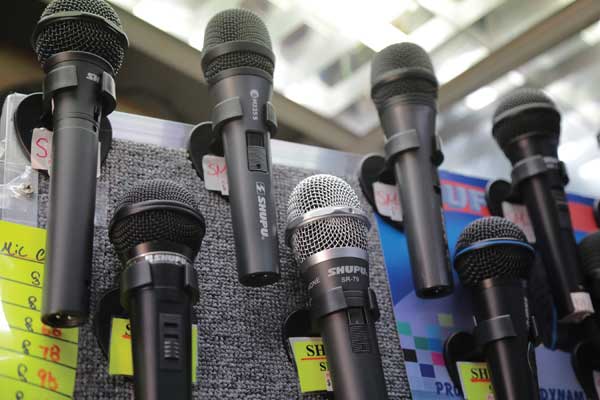Many microphones have been talked about as if they have this mystical ability to enhance performances, as if they can transform a crappy guitar into a handcrafted masterpiece or a mediocre vocalist into a diva. Is this true? Should you plunk down a few grand on a vintage Neumann U-87? Or will a Chinese-manufactured knock-off (see photo) costing a few hundred dollars do the trick? It’s true that the characteristics of some microphones make them sound better on some instruments and voices than others. We’ll try to explain why and what you should look for – so microphone detectives read on…
CONDENSER vs. DYNAMIC
A dynamic microphone uses a moving coil to create current that gets amplified; think of it like a speaker working in reverse. The venerable Shure SM57 and 58 are good examples. They are generally more rugged than their condenser counterparts. Because of the mass of the moving coil, dynamics tend to have poor transient response and on average are less sensitive than condensers.
Condenser mics on the other hand use a thin plastic film coated with gold or nickel, giving them very little mass – yes, you guessed it, making them more sensitive. Condensers also require phantom power to work, generally supplied by the preamp through one of the legs of the XLR cable. This sensitivity is a good thing when using them to capture the nuances of a soft vocal or acoustic guitar performance but can make them more prone to breakage if dropped or by putting a sensitive condenser mic inside a kick drum where the sound pressure levels can easily break the capsule. The size of the capsule (generally ranging from 3/8” to 1”) also has an effect on the characteristics and expense of the microphone.
RIBBON MICS
A ribbon mic is a dynamic mic that uses a thin metal ribbon clamped between two magnetic poles instead of a moving coil, so it responds to the moving air’s velocity rather than its pressure. Because it rejects signals from the sides, its Figure 8 pattern is excellent for setting up in a Blumlein stereo pattern (see our previous Performer article on miking techniques.) Ribbon mics have been known to provide a smoother, more detailed recording than moving coil dynamic mics but are less commonly used due to their more fragile nature.
DIRECTIONALITY, PADS & ROLL-OFF
Most often when you think about recording an instrument or voice, you think about just wanting to capture the sound straight on, especially when on-stage and the bleed from other instruments in close proximity is undesirable. For these applications, cardioid or hyper-cardioid patterned mics are what you want. Their heart shaped pickup pattern means that most of the sound hitting them from the sides and back will be rejected. But what if you want to record five singers in a room? In this case a microphone with an omni-directional pattern would be great. Or what if you have two singers facing each other? The Rode NT2-A ($400 street) is a large diaphragm condenser mic that offers a selection switch so that you can choose between Cardioid, Omni & Figure-8 Patterns to suit your needs. The NT2-A also offers switches to roll-off low frequencies (40Hz & 80Hz) and a Pad switch to lower the sensitivity of the mic for high volume situations.
Why would you want to roll off low frequencies? Let’s say you’re recording a female vocalist who is tapping her foot; by rolling off the low frequencies you can help lower the chances of recording foot thumps without losing any of her performance, as she isn’t likely to put out frequencies below 80Hz. On the other hand, if you were recording a kick drum you wouldn’t need the roll-off, but you might want the Pad switch on -10dB because of the high output of the drum.
USB
Plug and play, baby! These mics have their place – especially for dedicated uses like recording audio books or podcasts direct to your laptop or DAW. They eliminate the need for an interface box, external power supply and an XLR cable by putting the preamp in the mic itself. If you just need a basic mic to record clear demos in your bedroom, this could be the perfect streamlined solution. For instance, the AT2020 USB (appx $129 street) which is based on the outstanding AT-2020, allows you to plug a USB cable from the mic right into your computer and voilà! Stay tuned next month for part two in our series on mic selection…
ABOUT THE AUTHORS
Zac Cataldo is a musician and owner/producer at Night Train Studios, a recording studio in Westford, MA. He is also co-owner of Black Cloud Productions, a music publishing company. Reach him at zac at nighttrainstudios.com.
Brent Godin is a bassist/guitarist and engineer/producer at Night Train Studios. He is also a talent scout at Black Cloud Productions. Reach him at brent at blackcloudproductions.com.
